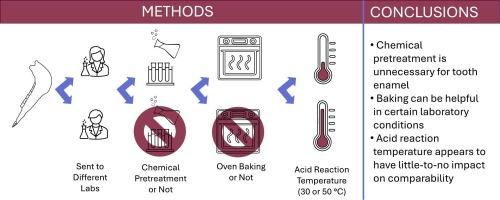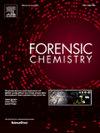提高牙釉质碳酸盐稳定同位素分析(δ13C, δ18O)的实验室间可比性
IF 2.2
3区 医学
Q2 CHEMISTRY, ANALYTICAL
引用次数: 0
摘要
人类牙釉质碳酸盐的碳氧同位素比值经常用于重建过去的饮食,运动和环境条件。尽管有长期的研究遗产,样品的制备和分析使用了非常广泛的协议,这种方法的异质性提出了关于同位素数据在研究中的可比性的问题。我们报告了在两个不同实验室测量的10个“现代”动物牙齿(从野外恢复获得)的同位素δ值的系统比较。我们的测试包括比较使用常用方案进行化学预处理的搪瓷粉亚样品和未进行预处理的亚样品。我们还评估了在(1)标准化用于样品酸化的反应温度和(2)在分析前烘烤样品和小瓶以去除水分时和在没有(1)标准化用于样品酸化的反应温度下产生的δ值。结果表明,两个实验室的δ值在样品进行化学预处理时存在系统差异,但未处理样品的差异较小或可以忽略不计。酸反应温度和烘烤的标准化也提高了可比性。我们认为,广泛采用的搪瓷样品化学预处理方法在很大程度上是不必要的,可能会损害稳定同位素分析的准确性。技术准备等级:trl4。本文章由计算机程序翻译,如有差异,请以英文原文为准。

Improving inter-laboratory comparability of tooth enamel carbonate stable isotope analysis (δ13C, δ18O)
Carbon and oxygen isotope ratios of human tooth enamel carbonate are frequently used for reconstruction of past diet, movement, and environmental conditions. Despite a long legacy of research, samples are prepared and analyzed using a remarkably broad range of protocols, and this methodological heterogeneity raises questions about the comparability of isotopic data across studies. We report a systematic comparison of isotope delta (δ) values for 10 “modern” faunal teeth (obtained from field recoveries) measured in two different laboratories. Our tests included comparisons of enamel powder subsamples that were chemically pretreated using commonly adopted protocols and subsamples that received no pretreatment. We also evaluated δ values generated with and without (1) standardizing the reaction temperature used for sample acidification and (2) baking the samples and vials to remove moisture before analysis. The results showed that δ values from the two laboratories were systematically different when samples were chemically pretreated, but that differences were smaller or negligible for untreated samples. Standardization of acid reaction temperature and baking also improved comparability. We suggest that the widely adopted practice of chemical pretreatment of enamel samples is largely unnecessary and may compromise the accuracy of stable isotope analyses.
Technology Readiness Level: TRL 4.
求助全文
通过发布文献求助,成功后即可免费获取论文全文。
去求助
来源期刊

Forensic Chemistry
CHEMISTRY, ANALYTICAL-
CiteScore
5.70
自引率
14.80%
发文量
65
审稿时长
46 days
期刊介绍:
Forensic Chemistry publishes high quality manuscripts focusing on the theory, research and application of any chemical science to forensic analysis. The scope of the journal includes fundamental advancements that result in a better understanding of the evidentiary significance derived from the physical and chemical analysis of materials. The scope of Forensic Chemistry will also include the application and or development of any molecular and atomic spectrochemical technique, electrochemical techniques, sensors, surface characterization techniques, mass spectrometry, nuclear magnetic resonance, chemometrics and statistics, and separation sciences (e.g. chromatography) that provide insight into the forensic analysis of materials. Evidential topics of interest to the journal include, but are not limited to, fingerprint analysis, drug analysis, ignitable liquid residue analysis, explosives detection and analysis, the characterization and comparison of trace evidence (glass, fibers, paints and polymers, tapes, soils and other materials), ink and paper analysis, gunshot residue analysis, synthetic pathways for drugs, toxicology and the analysis and chemistry associated with the components of fingermarks. The journal is particularly interested in receiving manuscripts that report advances in the forensic interpretation of chemical evidence. Technology Readiness Level: When submitting an article to Forensic Chemistry, all authors will be asked to self-assign a Technology Readiness Level (TRL) to their article. The purpose of the TRL system is to help readers understand the level of maturity of an idea or method, to help track the evolution of readiness of a given technique or method, and to help filter published articles by the expected ease of implementation in an operation setting within a crime lab.
 求助内容:
求助内容: 应助结果提醒方式:
应助结果提醒方式:


